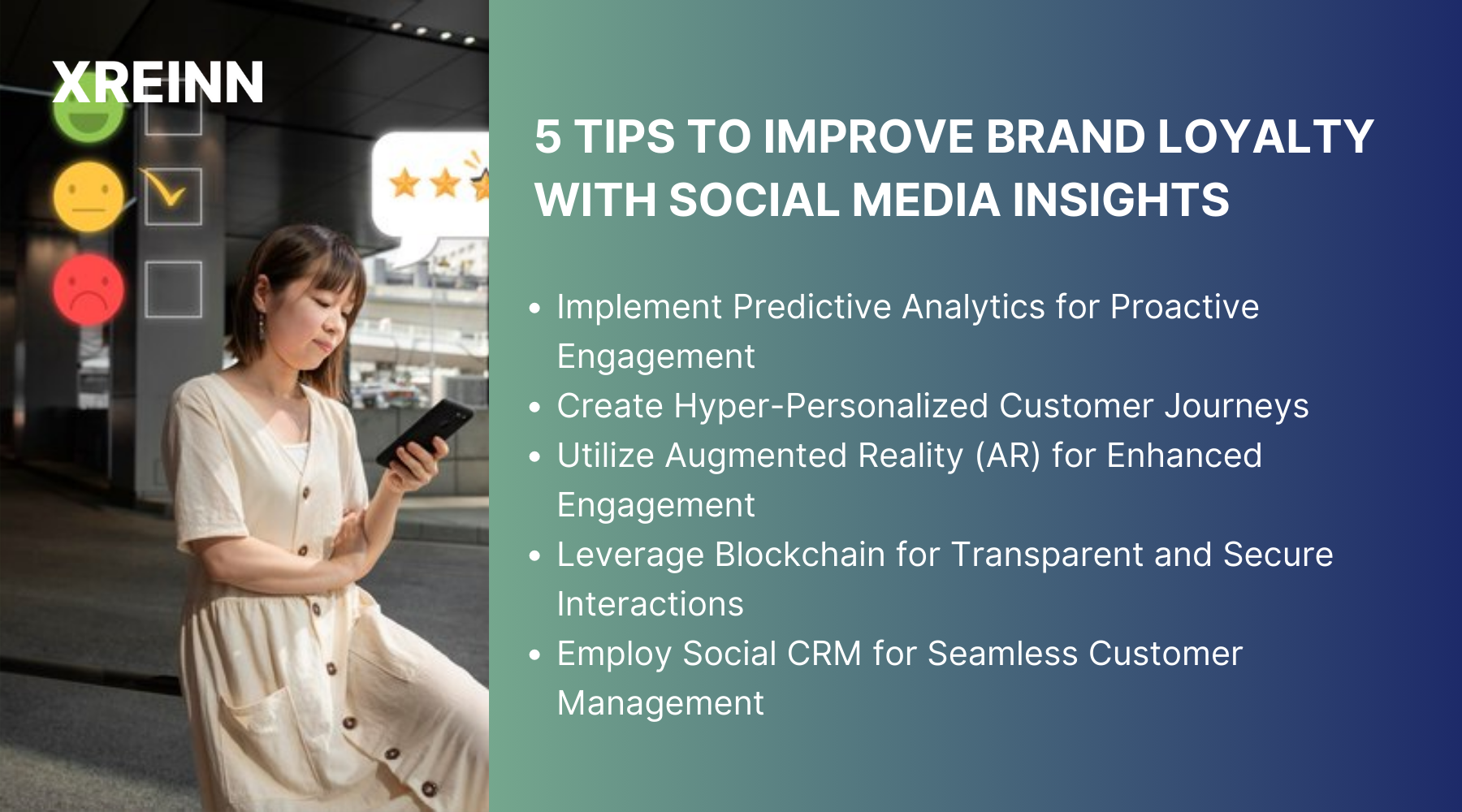Social Listening
5 Proven Tips to Improve Brand Loyalty Using Social Media Insights
Jul 01, 2024
In a world where customer loyalty can make or break your brand, the fear of falling behind is all too real. Mastering advanced social media strategies isn't just an option - it's a necessity. Brand loyalty today goes beyond offering great products or services; it's about connecting with your audience on a deeper level and anticipating their needs.
If you're ready to improve your expertise and gain actionable insights, you've come to the right place. These five advanced tips will help you transform your social media presence into a powerful tool enabling unwavering customer loyalty.
5 Tips to Improve Brand Loyalty with Social Media Insights

1. Implement Predictive Analytics for Proactive Engagement
Predictive analytics is one of the important factors in social media strategy, offering a proactive approach to customer engagement. Rather than reacting to trends as they happen, predictive analytics allows you to anticipate customer needs and behaviors, enabling you to engage more effectively and stay ahead of the competition.
How to Implement Predictive Analytics
To start, you'll want to utilize advanced tools. Investing in sophisticated analytics platforms such as IBM Watson or Adobe Analytics can be a great move. These tools are capable of processing vast amounts of data to identify patterns and forecast future behaviors, giving you a significant edge in understanding and anticipating customer actions.
Next, it's important to analyze historical data. By going deep into your past social media interactions, you can uncover patterns in customer behavior that might not be immediately obvious. This historical data is invaluable as it serves as the foundation for building accurate and effective predictive models.
Finally, develop predictive models that can accurately forecast customer needs and behaviors. For example, by analyzing the frequency and timing of customer inquiries, you can anticipate when your customers are most likely to need support. This allows you to proactively offer solutions and engage with your audience before issues arise, thereby enhancing customer satisfaction and loyalty.
Benefits
1. Predictive analytics allows you to engage customers before they realize they need it, creating a seamless and satisfying customer experience.
2. By identifying potential issues early, you can address them before they escalate, reducing the likelihood of losing customers.
3. Consider a tech company that used predictive analytics to identify potential software bugs before a major update, allowing them to address issues preemptively and maintain customer trust.
2. Create Hyper-Personalized Customer Journeys
Hyper-personalization is the next frontier in customer engagement, going beyond basic personalization to deliver highly tailored experiences that resonate deeply with individual customers. This approach uses data to predict and meet individual needs in real-time.
How to Achieve Hyper-Personalization
1. Gather comprehensive data from various touchpoints—social media interactions, purchase history, and website behavior. Use this data to build a detailed profile of each customer.
2. Employ AI and machine learning algorithms to analyze this data and deliver personalized content and offers in real time. Tools like Dynamic Yield can help automate this process.
3. Break your audience into micro-segments based on detailed criteria such as behavior, preferences, and past interactions. This enables more precise targeting and messaging.
Implementation
Creating dynamic content is essential for engaging your audience more effectively. Develop content that adapts based on user interactions, ensuring that it remains relevant and appealing. For example, an e-commerce site can display different products based on a user’s browsing history, offering a personalized shopping experience that encourages further engagement and purchases.
In addition to dynamic content, personalize your retargeting ads. Use data to create highly targeted ads that reflect individual user behavior and preferences. This level of personalization can significantly increase the effectiveness of your marketing efforts, making your audience feel understood and valued.
3. Augmented Reality (AR) for Enhanced Engagement
Augmented Reality (AR) offers a unique opportunity to create immersive and engaging brand experiences that appeal to your audience. By integrating AR into your social media strategy, you can provide interactive experiences that stand out and drive deeper engagement.
How to Integrate AR
Developing AR filters and experiences is a powerful way to engage your audience on social media platforms like Instagram and Snapchat. Create custom AR filters that range from simple face filters to interactive games, all designed to promote your brand and captivate your audience.
Additionally, use AR for virtual try-ons and demos, allowing customers to try on products virtually or interact with 3D models. This is particularly effective for fashion, beauty, and home decor brands, as it offers customers a hands-on experience with your products from the comfort of their homes.
Furthermore, partner with influencers to show your AR features. Influencers can demonstrate how to use your AR experiences, driving engagement and extending your reach. By using the popularity and trust that influencers have with their followers, you can effectively introduce your AR features to a broader audience, enhancing both engagement and brand loyalty.
Advantages
1. AR experiences are unique and memorable, helping your brand stand out in a crowded market.
2. AR content tends to have higher engagement rates as users are more likely to interact with immersive and fun experiences.
4. Blockchain for Transparent and Secure Interactions
Blockchain technology, often associated with cryptocurrencies, has practical applications for social media marketing. It can improve transparency and security, which are important for building and maintaining trust with your audience.
How to Utilize Blockchain
To effectively use blockchain in your social media strategy, start by ensuring transparency in influencer partnerships. Use blockchain technology to create transparent and verifiable contracts with influencers, ensuring that all terms are clear and mutually agreed upon. This reduces the risk of disputes and enables trust between your brand and the influencers you collaborate with.
Next, implement blockchain to secure customer data. Blockchain's decentralized nature makes it highly secure, providing a robust safeguard for your customers' information. This can significantly reassure your customers that their data is safe, thereby enhancing their trust in your brand.
Additionally, develop blockchain-based loyalty programs. By using blockchain to track and verify rewards, you can ensure that these rewards are fair and verifiable. This transparency not only builds trust but also encourages continued engagement with your loyalty programs, ultimately strengthening customer loyalty and brand loyalty.
Benefits
Improving trust and credibility is important for building long-term customer loyalty, and transparency and security play a pivotal role in this. Blockchain technology ensures that all interactions and transactions are secure and tamper-proof, providing a powerful foundation for trust.
5. Employ Social CRM for Seamless Customer Management
Social Customer Relationship Management (Social CRM) combines traditional CRM with social media management, providing a holistic approach to customer interaction and engagement.
How to Implement Social CRM
1. Use tools like Salesforce Social Studio or Zoho Social to integrate social media with your existing CRM system. This allows you to manage and analyze all customer interactions in one place.
2. Monitor and manage customer interactions across all social media platforms. This ensures that you have a complete view of each customer’s journey.
3. Use the data collected through social CRM to personalize customer communication and service. Identify trends and patterns to improve your overall strategy.
Advantages
Adopting social CRM offers several significant advantages. Firstly, it ensures a unified customer experience by providing a seamless journey across all touchpoints through a comprehensive view of each customer.
This holistic approach enables the personalization of service and communication, thereby improving customer satisfaction. When customers feel understood and valued, their loyalty naturally increases, leading to higher retention rates and stronger overall brand loyalty.
Conclusion
Building brand loyalty in today’s digital age requires more than just traditional strategies. By implementing advanced techniques like predictive analytics, hyper-personalization, augmented reality, blockchain, and social CRM, you can create deeper, more meaningful connections with your audience. These strategies not only enhance customer engagement but also build long-term loyalty, ensuring that your brand remains competitive and relevant.
Implement these tips and watch as your brand loyalty soars. Remember, the key to success lies in staying adaptive and continuously learning from your social media insights.

Data Analytics
Jun 27, 2024Master key concepts in data analytics with practical tips to enhance decision-making and achieve success in your projects and professional growth

Data Analytics
Jul 01, 2024Learn the essential stages of the data analytics workflow to turn your data into valuable business insights and drive growth.

